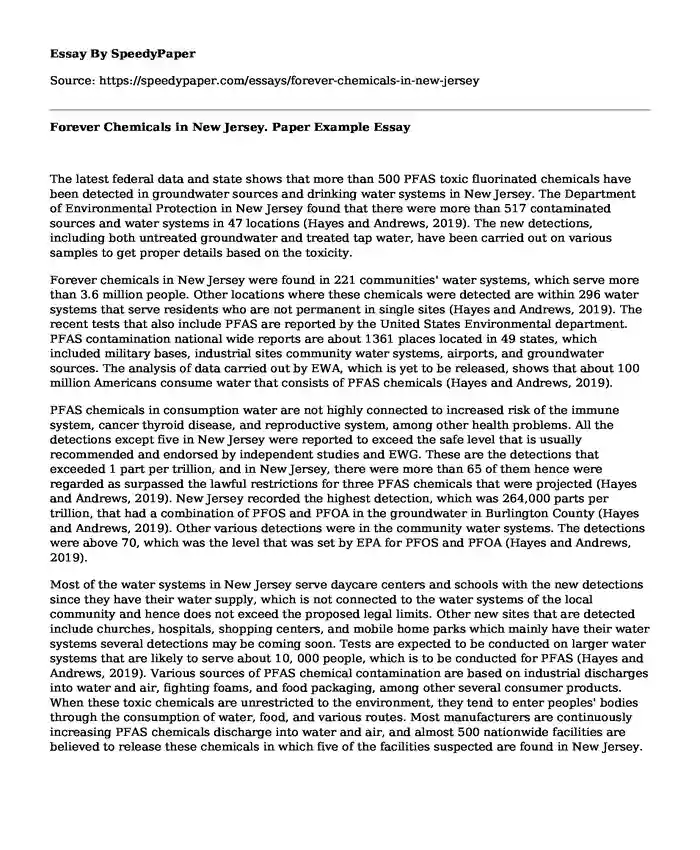The latest federal data and state shows that more than 500 PFAS toxic fluorinated chemicals have been detected in groundwater sources and drinking water systems in New Jersey. The Department of Environmental Protection in New Jersey found that there were more than 517 contaminated sources and water systems in 47 locations (Hayes and Andrews, 2019). The new detections, including both untreated groundwater and treated tap water, have been carried out on various samples to get proper details based on the toxicity.
Forever chemicals in New Jersey were found in 221 communities' water systems, which serve more than 3.6 million people. Other locations where these chemicals were detected are within 296 water systems that serve residents who are not permanent in single sites (Hayes and Andrews, 2019). The recent tests that also include PFAS are reported by the United States Environmental department. PFAS contamination national wide reports are about 1361 places located in 49 states, which included military bases, industrial sites community water systems, airports, and groundwater sources. The analysis of data carried out by EWA, which is yet to be released, shows that about 100 million Americans consume water that consists of PFAS chemicals (Hayes and Andrews, 2019).
PFAS chemicals in consumption water are not highly connected to increased risk of the immune system, cancer thyroid disease, and reproductive system, among other health problems. All the detections except five in New Jersey were reported to exceed the safe level that is usually recommended and endorsed by independent studies and EWG. These are the detections that exceeded 1 part per trillion, and in New Jersey, there were more than 65 of them hence were regarded as surpassed the lawful restrictions for three PFAS chemicals that were projected (Hayes and Andrews, 2019). New Jersey recorded the highest detection, which was 264,000 parts per trillion, that had a combination of PFOS and PFOA in the groundwater in Burlington County (Hayes and Andrews, 2019). Other various detections were in the community water systems. The detections were above 70, which was the level that was set by EPA for PFOS and PFOA (Hayes and Andrews, 2019).
Most of the water systems in New Jersey serve daycare centers and schools with the new detections since they have their water supply, which is not connected to the water systems of the local community and hence does not exceed the proposed legal limits. Other new sites that are detected include churches, hospitals, shopping centers, and mobile home parks which mainly have their water systems several detections may be coming soon. Tests are expected to be conducted on larger water systems that are likely to serve about 10, 000 people, which is to be conducted for PFAS (Hayes and Andrews, 2019). Various sources of PFAS chemical contamination are based on industrial discharges into water and air, fighting foams, and food packaging, among other several consumer products. When these toxic chemicals are unrestricted to the environment, they tend to enter peoples' bodies through the consumption of water, food, and various routes. Most manufacturers are continuously increasing PFAS chemicals discharge into water and air, and almost 500 nationwide facilities are believed to release these chemicals in which five of the facilities suspected are found in New Jersey.
References
Hayes, J., & Andrews, D. (2019). 'Forever Chemicals' in Over 500 N.J. Water Systems and Sources - More Than 1,000 Contamination Sites Nationwide. Retrieved 7 April 2020, from https://www.ewg.org/news-and-analysis/2019/10/forever-chemicals-almost-200-nj-water-systems-and-sources-more-1000
Cite this page
Forever Chemicals in New Jersey. Paper Example. (2023, May 09). Retrieved from https://speedypaper.net/essays/forever-chemicals-in-new-jersey
Request Removal
If you are the original author of this essay and no longer wish to have it published on the SpeedyPaper website, please click below to request its removal:
- Essay Example: Cash Flow and Profit Margin Study
- Essay Sample on Project Management for Constructing a Stadium
- Report on Big Data Analytics with Hive, Free Example
- Essay Sample Describing Three Arms of Government
- Federalism in the United States - Essay Sample for Free Download
- Essay Sample on Blood Test: Uric Acid, Antinuclear Antibodies Direct
- Paper Example on Architecture: 5-Year Degree, Internships, Average $79,380 Salary
Popular categories





